4 wm 金属有机配合物
- 格式:pptx
- 大小:2.41 MB
- 文档页数:61
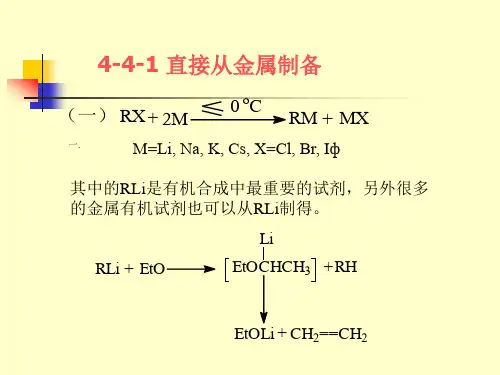

重庆大学本科学生毕业设计(论文)基于羧酸配体的金属有机配合物设计与组装学生:李洪江学号:20116650指导教师:龚云专业:应用化学重庆大学化学化工学院二O一五年六月Graduation Design(Thesis) of Chongqing UniversityDesign and assembly of metal organic complexes based on carboxylic ligandUndergraduate: Li HongjiangSupervisor: Prof. Gong YunMajor: Applied ChemistryChemistry and Chemical Engineering Chongqing UniversityJune 2015中文摘要金属-有机骨架材料(MOFs)是以金属离子或金属簇作为连接点,以有机配体作为连接体构成的无限延伸的网络结构,在储能、催化以及分离等方面都起到了广泛的作用,可能充当分子识别、选择催化、超高纯度分离、光致变色、生物传导、光电等新型材料。
由于金属-有机骨架材料(MOFs)具有结晶度高、纯度高、成本低,结构可控等一系列优点,它近些年来受到了全世界材料学研究者们的广泛关注。
本文采用水热法,利用4-(4-氧基-1-吡啶) 邻苯二甲酸(H2L)与Cd2+,采用水热法合成了两种金属-有机骨架配合物:CdL(H2O)2 (1)和C dL (2),并对配合物1和2的结构进行了单晶X射线衍射表征。
在配合物1和2中,配体L2-采用不同的配位方式,但是这两个配合物都是二维层状结构。
粉末X射线衍射数据表明得到的配合物1是纯相样品。
本文还对配合物1进行了紫外可见光谱和热稳定性测试。
关键词:金属-有机骨架,水热合成,含氮羧酸,晶体结构ABSTRACTMetal-organic frameworks (MOFs) possess infinite extensive network in which metal ions or metal cluster act as nodes and organic ligands function as linkers, they play important roles in storing energy, catalyzing and separation and they may have potential applications in molecular recognition, selective catalysis, separation with ultra-high purity, photochromism, biology conduction and photoelectric field. Because MOFs have a serial of advantages such as high crystallinity, high purity, low cost and adjustable structures, they have drawn extensive attention by the researchers all over the world.In this paper, using 4-(4-oxypyridinium-1-yl)phthalic acid (H2L) and Cd2+, two MOFs formulated as CdL(H2O)2 (1) and C dL (2) have been synthesized hydrothermally. The two MOFs have been structurally characterized by single crystal X-ray diffraction. In complexes 1and 2, L2- ligand adopts different coordination modes, but the two complexes are two dimensional (2D) layer structures. Powder X-ray diffraction data indicates the bulk sample of complex 1is in pure phase. The UV-vis spectrum and thermally stability of complex 1 have also been measured.Key words:MOFs, hydrothermal synthesis, Carboxylic ligand containing N atom, crystal structure目录中文摘要 (I)ABSTRACT (II)1 绪论 (1)1.1 金属-有机骨架配合物的简介 (1)1.2 金属-有机骨架配合物的分类 (1)1.2.1 含氮杂环有机配体构筑MOFs (2)1.2.2 羧酸有机配体构筑MOFs (2)1.2.3 含氮杂环配体与羧酸有机配体构筑MOFs (2)1.2.4 含膦酸配体构筑MOFs (2)1.3 金属-有机骨架配合物的合成方法 (3)1.3.1 溶液挥发法 (3)1.3.2 界面扩散法 (3)1.3.3 熔融盐法 (3)1.3.4 水热法和溶剂热法 (4)1.4 金属有机配合物的应用 (5)1.4.1金属有机配合物在光学材料方面的研究 (5)1.4.2 金属有机配合物在磁性材料方面的研究 (5)1.4.3 金属有机配合物在微孔材料方面的研究 (6)1.4.4 金属有机配合物在催化反应中的研究 (7)1.4.5金属有机配位聚合物在超分子方面的研究 (7)1.5 本课题的选题目的、意义以及主要的研究方法 (8)1.5.1 本课题选题的目的和意义 (8)1.5.2 本课题的主要研究内容 (8)1.6 本论文主要使用的仪器 (9)2 两种配合物的合成 (10)2.1 实验部分 (10)2.1.1 试剂和仪器 (10)2.1.2 配合物CdL(H2O)2 (1)的合成 (10)2.1.3 配合物CdL (2)的合成 (10)2.2 配合物1与配合物2的合成区别 (11)2.3 实验中拍摄配合物实体照片的简要分析 (11)3 两种配合物的结构、参数和性质 (12)3.1 配合物CdL(H2O)2 (1)的配位方式和结构 (12)3.1.1 配合物1的配位方式 (12)3.1.2 配合物1的结构 (13)3.1.3 配合物1的相关数据 (14)3.1.4 配合物1的键长与键角 (15)3.2 配合物1的性质 (16)3.2.1 配合物1的红外光谱 (16)3.2.2 配合物1的热重分析 (17)3.3 配合物CdL (2)的配位方式和结构 (18)3.3.1 配合物2的配位方式 (18)3.3.2 配合物2的结构 (19)3.3.3 配合物2的相关数据 (20)3.3.4 配合物2的键长与键角 (21)3.4 两种配合物的紫外光谱 (22)3.4.1 紫外-可见吸收光谱 (22)4 结论与展望 (24)4.1 结论 (24)4.2 展望 (24)参考文献 (25)1 绪论1.1 金属-有机骨架配合物的简介金属-有机骨架配合物材料是主要由含氮或者含氧的有机配体与一些过渡金属离子连接从而形成可能拥有网状孔隙结构骨架的材料,我们简称MOFs[1-5]。

《手性3d-4f金属配合物和金属凝胶的合成、结构及性能研究》篇一手性3d-4f金属配合物和金属凝胶的合成、结构及性能研究摘要:本文致力于研究手性3D/4F金属配合物和金属凝胶的合成方法、结构特征以及性能表现。
通过深入探讨其合成过程中的化学反应、结构分析以及实际应用性能,为相关领域的研究提供理论依据和实践指导。
一、引言手性金属配合物和金属凝胶作为近年来化学领域的研究热点,因其独特的结构和优异的性能在材料科学、生物医学和纳米技术等领域展现出巨大的应用潜力。
本文将重点对手性3D/4F金属配合物和金属凝胶的合成方法、结构特点及性能进行深入研究。
二、合成方法1. 手性3D金属配合物的合成手性3D金属配合物的合成主要采用有机配体与金属离子在适当的溶剂中发生配位反应。
通过控制反应条件,如温度、pH值、浓度等,可得到具有特定结构的3D金属配合物。
2. 手性4F金属配合物的合成手性4F金属配合物的合成过程中,除了常规的配位反应外,还需引入具有四个配位点的配体,通过与金属离子的配位作用,形成具有特定空间结构的4F金属配合物。
3. 金属凝胶的合成金属凝胶的合成主要通过将金属盐与特定类型的配体或凝胶因子混合,通过化学或物理交联作用形成具有三维网络结构的凝胶。
通过调整配体和金属盐的比例、种类等条件,可控制金属凝胶的形态和性能。
三、结构特点1. 手性3D金属配合物的结构特点手性3D金属配合物具有复杂的空间结构,通过配位键和氢键等相互作用形成三维网络结构。
其结构中往往包含大量的手性中心,使得整个配合物具有手性特性。
2. 手性4F金属配合物的结构特点手性4F金属配合物具有更高的配位饱和度和更复杂的空间结构。
其配体具有四个配位点,与金属离子形成更加稳定的配位作用,使得整个配合物具有更高的稳定性和更复杂的空间结构。
3. 金属凝胶的结构特点金属凝胶具有三维网络结构,通过金属离子与配体之间的配位作用或物理交联作用形成。
其结构中包含大量的孔洞和通道,使得金属凝胶具有较高的比表面积和良好的吸附性能。
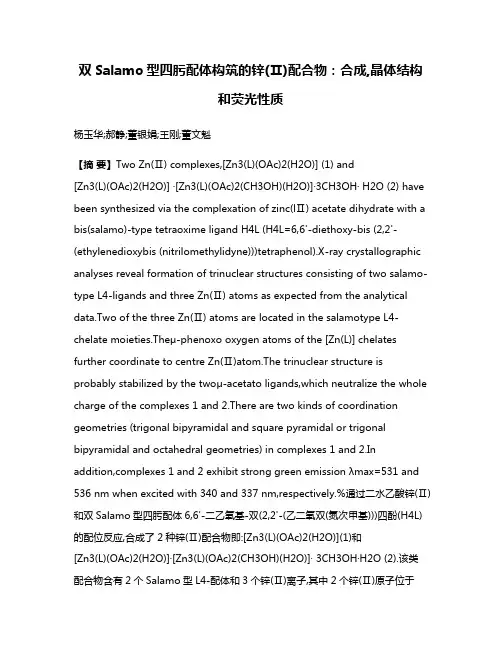
双Salamo型四肟配体构筑的锌(Ⅱ)配合物:合成,晶体结构和荧光性质杨玉华;郝静;董银娟;王刚;董文魁【摘要】Two Zn(Ⅱ) complexes,[Zn3(L)(OAc)2(H2O)] (1) and[Zn3(L)(OAc)2(H2O)] ·[Zn3(L)(OAc)2(CH3OH)(H2O)]·3CH3OH· H2O (2) have been synthesized via the complexation of zinc(lⅡ) acetate dihydrate with a bis(salamo)-type tetraoxime ligand H4L (H4L=6,6'-diethoxy-bis (2,2'-(ethylenedioxybis (nitrilomethylidyne)))tetraphenol).X-ray crystallographic analyses reveal formation of trinuclear structures consisting of two salamo-type L4-ligands and three Zn(Ⅱ) atom s as expected from the analytical data.Two of the three Zn(Ⅱ) atoms are located in the salamotype L4-chelate moieties.Theμ-phenoxo oxygen atoms of the [Zn(L)] chelates further coordinate to centre Zn(Ⅱ)atom.The trinuclear structure is probably stabilized b y the twoμ-acetato ligands,which neutralize the whole charge of the complexes 1 and 2.There are two kinds of coordination geometries (trigonal bipyramidal and square pyramidal or trigonal bipyramidal and octahedral geometries) in complexes 1 and 2.Inaddit ion,complexes 1 and 2 exhibit strong green emission λmax=531 and 536 nm when excited with 340 and 337 nm,respectively.%通过二水乙酸锌(Ⅱ)和双Salamo型四肟配体6,6'-二乙氧基-双(2,2'-(乙二氧双(氮次甲基)))四酚(H4L)的配位反应,合成了2种锌(Ⅱ)配合物即:[Zn3(L)(OAc)2(H2O)](1)和[Zn3(L)(OAc)2(H2O)]·[Zn3(L)(OAc)2(CH3OH)(H2O)]· 3CH3OH·H2O (2).该类配合物含有2个Salamo型L4-配体和3个锌(Ⅱ)离子,其中2个锌(Ⅱ)原子位于Salamo型螯合单元的N2O2空腔内.[Zn(L)]螯合物中桥联的酚氧原子进一步和中心的锌(Ⅱ)原子配位.这类结构能通过2个桥联的乙酸根配体稳定,从而使配合物1和2达到电荷平衡.配合物有2种不同的几何构型即扭曲的三角双锥和四方锥(配合物1)或三角双锥和八面体(配合物2).另外,配合物1和2在激发波长为340和337 nm时能发出强的绿光,其最大发射波长分别为531和536 nm.【期刊名称】《无机化学学报》【年(卷),期】2017(033)007【总页数】13页(P1280-1292)【关键词】双Salamo型四肟配体;锌(Ⅱ)配合物;合成;晶体结构;荧光性质【作者】杨玉华;郝静;董银娟;王刚;董文魁【作者单位】兰州交通大学化学与生物工程学院,兰州 730070;兰州交通大学化学与生物工程学院,兰州 730070;兰州交通大学化学与生物工程学院,兰州 730070;兰州交通大学化学与生物工程学院,兰州 730070;兰州交通大学化学与生物工程学院,兰州 730070【正文语种】中文【中图分类】O614.24+1The salen-type ligand and its metal complexes were discovered since the 19th century,the synthesis of the salen-type complexes have been extensively investigated for the past several decades[1],At present, some significant applications in the research of the transitionmetal complexeswith salen-type ligands has been observed,and these complexeshave been widely used in many areas,such as asymmetric catalysis[2], dioxygen carriers[3],Luminescent and magnetic properties[4-11]and biological activities,for instance,sterilization,anti-virusand anticancerand soon[12-20].Although the studies of salen-[21-25]or salamo-type[26-37]ligands and their complexes have made great progress,but it is very rarely that the study on bis(salen)-type ligands and theirmetal complexes[38-39].These bis(salen)-type ligands containing two salen-type moieties are also fascinating because some novel functions originating from the cooperation of several metal centers are expected.And thesebis(salen)-type ligands play an important role in the selective strong binding with metal(ⅡorⅢ)atoms in coordination chemistry.These metal complexes also have some important practical values[40-41].In order to further investigate syntheses,crystal structures and properties ofmetal complexes with bis (salen)-type ligands,herein,we report syntheses, structural characterizations and fluorescent properties of two newbis(salamo)-type Zncomplexes,[Zn3(L)(OAc)2(H2O)](1)and[Zn3(L)(OAc)2(H2O)]·[Zn3(L)(OAc)2(CH3OH)(H2O)]·3CH 3OH·H2O(2)via the complexation of zincacetate dihydrate with abis(salamo)-type tetraoxime ligand H4L.Furthermore,the fluorescence behavior of complexes 1 and 2 in DMF are discussed.1.1 M aterials and physicalmeasurements3-Ethoxy-2-hydroxybenzaldehyde was purchased from Aldrich and used without further purification. Other reagents and solvents were analytical grade reagents from Tianjin Chemical Reagent Factory.C,H and N analyseswere carried out with a GmbH VariuoEL V3.00 automatic elemental analyzer. Elementa l analysis for Zn was detected by an IRIS ER/S·WP-1 ICP atomic emission spectrometer.1H NMR spectra were recorded on a Mercury-400BB spectrometer.UV-Vis absorption and fluorescence spectrawere recorded on a Shimadzu UV-2550 spectrometer and Perkin-Elmer LS-55 spectrometer,respectively.X-ray single crystal structures were determined on a Bruker Smart APEX CCD area detector.Electrolytic conductance measurements were made with a DDS-11D type conductivity bridge using a 1mmol·L-1solution in DMF at room temperature.Melting points were measured by the use of a microscopic melting point apparatus made in Beijing Taike Instrument Limited Company,and the thermometer was uncorrected.1.2 Syntheses of H4L and its Zncomplexes 1 and 2Synthetic route to H4Lis shown in Scheme 1.H4Lwas synthesized according to an analogous method reported earlier[39,42-45].m.p.401~402 K.1H NMR(400 MHz,CDCl3):δ=3.93(s,6H,-CH3),4.46~4.53(m,8H, -OCH2CH2O-),4.63(dt,J=5.4,1.5Hz,4H,-OCH2-),6.77 (s,2H,Ph-H),6.78~6.86(m,4H,Ph-H),6.93(dd,J= 7.2,2.2 Hz,2H,Ph-H),8.25(s,2H,N=CH),8.28(s,2H,N=CH),9.60(s,2H,-OH),9.69(s,2H,-OH).Anal. Calcd.forC30H34N4O10(%):C,59.01;H,5.61;N,9.18. Found(%):C,59.15;H,5.57;N,8.96.A solution of Znacetate monohydrate(3.26 mg,0.015 mmol)in ethanol(3.0 mL)was added dropwise to a solution of H4L(3.03 mg,0.005 mmol) in CHCl3(1.0 mL).The color of the mixing solution turned to bright yellow immediately,the mixture was filtered and the filtrate was allowed to standat room temperature for about two weeks.Along with partially volatilization of solvent of the mixed solution and several yellow block-shaped single crystals suitable for X-ray crystallographic analysis were obtained. Yield:51.6%(2.4mg).Anal.Calcd.for[Zn3(L)(OAc)2(H2O)](C34H38N4O15Zn3)(%):C,43.46;H,4. 05;N,5.97; Zn,20.93.Found(%):C,43.41;H,4.07;N,5.99;Zn, 20.88.The single crystals of 2 were grown up by a similar procedure aforementioned takingZn(OAc)2· H2O(3.26mg,0.015mmol)inmethanol(3mL)and H4L (3.03mg,0.005 mmol)in 1.0 mL THF solution.The obtained bright yellow mixture was filtered and the filtrate was allowed to stand was stand at room temperature for three weeks.The solventwas partially evaporated and obtained yellow block-like single crystals suitable for X-ray crystallographic analysis. Yield:57.7%(3.4mg).Anal.Calcd.for[Zn3(L)(OAc)2(H2O)]·[Zn3(L)(OAc)2(CH3OH)(H2O)]·3CH3 OH·H2O (C72H93N8O35Zn6)(%):C,42.75;H,4.63;N,5.54;Zn,19.40.Found(%):C,42.39;H,4.56;N,5.61;Zn,18.97. 1.3 Crystal structure determ inationX-ray diffraction data were collected on a Bruker Smart Apex CCD diffractometer at 298(2)K. Using graphitemonochromatized MoKαradiation(λ= 0.071 073 nm).The structures were solved using the directmethod and refined by full-matrix least-squares on F2using the SHELXL-97 program package[46].All non-hydrogen atoms were refined anistropically and hydrogens were added in calculated positions andrefined usinga ridingmodel.The X-ray crystallographic datacollection,solution and refinement parameters for the Zncomplexes are summarized in Table 1.CCDC:864890,1;1470489,2.2.1 M olar conductanceComplexes 1 and 2 are soluble in DMF and DMSO,CHCl3,butnotsoluble in EtOH,MeOH,MeCN, THF,acetone and ethyl plexes 1 and 2 display good stability in air at room temperature. Meanwhile,H4L is soluble in aforementioned solvents. Molar conductance values of complexes 1 and 2(1 mmol·L-1in DMF)at 298 K are 3.4 and 5.7 S·m2· mol-1,respectively,indicating complexes 1 and 2 are non-electrolyte.2.2 FT-IR spectraThe IR spectra of H4L and its complexes 1 and 2 show a characteristic C=N stretching band.For the free ligand H4L this band appears at 1 608 cm-1, while the C=N bandsof complexes1 and 2 are observed at 1 616 and 1 612 cm-1,respectively.These shifts toward higher wavenumbers of the C=N absorption of about 8~6 cm-1on going from H4L to complexes 1 and 2 suggest a weak p-accepting ability of the coordinated ligand[47].The Ar-O stretching frequencies appear as a strong band within the 1 265~1 213 cm-1range,as reported for similar salen-type ligands.These bands occur at 1 265 cm-1for H4L,1 260 cm-1for complex 1 and 1 263 cm-1for complex 2.The Ar-O stretching frequency is shifted to a lower value,indicating that the Zn-O bond was formed between the Znatoms and oxygen atoms of the phenolic groups[27-31,45].The O-H stretching frequency of H4L appears at 3 410 cm-1.In addition,the broad absorption centered on 3 384,3 420 and 3 419 cm-1in complexes 1 and 2,respectively,which may be assigned to the O-H stretching vibration ofwater ormethanolmolecules.2.3 UV-Vis absorption spectraThe absorption spectra of H4L and its complexes 1 and 2 in diluted DMF solution are shown in Fig.1. It can be seen that the absorption peaks of complexes 1 and 2 are obviously different from H4L upon complexation,and the spectral shapes of complexes 1 and 2 are similar to each other.An important feature of the absorption spectrum of H4L is shown that two absorption peaks are observed at 273 and 310nm,respectively.The former absorption peak at 273 nm can be assigned to theπ-π*transition of the benzene rings and the latt er one at 310 nm can be attributed to the intra-ligandπ-π*transition of the C=N bonds[28-29]. Compared with the absorption peak of H4L,there are three absorption peaks in complexes 1 and 2.The former absorption peak at 273 nm in H4L was shifted to 285 and 287 nm in complexes 1 and 2,respectively. Meanwhile,the other absorption peak at 310 nm in H4L was shifted to 328 and 331 nm in complexes 1 and 2,which was shifted by ca.18 and 21 nm, respectively.The absorption peaks of 273 and 310 nm were red-shifted upon coordination to the Zn(II)atoms in complexes 1 and 2,which can be assigned to the π-π*transitions of the salamo-type ligand.In addition,a new absorption peak at 439 and 442 nmwas observed in complexes 1 and 2,respectively.2.4 Description of the crystal structures2.4.1 Crystal structure of complex 1Selected bond lengths and angles for complex 1 are presented in Table plex 1 crystallizes in themonoclinic system,spacegroupP21/c.Theassembly of three Znatoms,one L4-ligand units,two acetate ions and one coordinated H2O molecule results in atrinuclearZncomplex(Fig.2).In molecule unit of complex 1,three Znatoms are all pentacoordinated.Firstly,the terminal Znatom(Zn2)is penta-coordinated by two oxime nitrogen(N1 and N2) and phenolic oxygen(O1 and O5)atoms of the bis (salamo)-type L4-unit and one oxygen(O12)atom of one chelating acetate ion.Secondly,the centre Znatom(Zn1)is penta-coordinated by two bridging phenolic oxygen(O1 and O2)atoms of the bis(salamo) -type L4-unit,two oxygen(O11 and O13)atoms of the chelating acetate ions and one oxygen(O15)atom from one coordinated water molecule in the apical position.At last,The terminal Znatom(Zn3)is penta-coordinated by two oxime nitrogen(N3 and N4) and phenolic oxygen(O2 and O9)atoms of the bis (salamo)-type L4-unit and one oxygen(O14)atom ofthe chelating acetate ion.The two chelating acetate ions coordinate to the three Znatoms via a familiar Zn1-O-C-O-Zn2 and Zn1-O-C-O-Zn3 coordinatedmodes.The Zn1 atom adopts a slightly distorted square pyramidalgeometry(τ=0.470)[18],which deviate from themean plane(O1-O2-O11-O13)by 0.029 5(3)nm. The distance of Zn1 atom to the five donor atoms are all different(0.198 8(5)~0.206 1(5)nm).The distances from the fouratoms to the mean plane are not equal (0.030 0~0.034 2 nm),and the distances from phenolic oxygen atom(O2)of the bis(salamo)-type L4-unit to themean plane is 0.221 8(4)nm.The Zn2 atom also adopts a slightly distorted square pyramidal geometry (τ=0.373),Four coordinationatoms(O1,O5,N1 and N2)give a mean plane,and the Zn2 atom deviate from themean plane by 0.037 4(4)nm.The distances from the five coordination atoms to the mean plane are not equal:O1 and N2 above average by 0.021 3(3) and 0.019 1(3)nm,O5 and N1 below average by0.020 8(4)and 0.019 6(3)nm,respectively.In addition, one oxygenatom(O6)of the acetate ion deviates from themean plane by 0.2367(3)nm.The dihedral angle of O1-Zn2-N1 and O5-Zn2-N2 is32.97(3)°.Interestingly,the geometry of the Zn3 atom is different from the Zn1 and Zn2 atoms.The value ofτ=0.671 c learly indicates that the environment of the Zn3 atom is a trigonal bipyramidal geometry in which the axial positions are occupied by O2 and N4 atoms.Which deviate from themean plane(O9-N3-O14)by 0.007 4(3) nm.The distance of the Zn3 atom to the five donor atomsarealldifferent(0.1976(5),0.1992(5),0.2015(4), 0.213 4(5)and 0.214 4(5)nm,respectively).The dihedral angle between the plane of N3-Zn1-O2 and thatof N4-Zn1-O9 is 53.10(3)°,which indicates the L4-unit has serious distortion.Thus,two kinds of type coordination geometries(trigonal bipyramidal and square pyramidal)are showed in complex 1.2.4.2 Crystal structure of complex 2Selected bond lengths and angles for complex 2 are presented in(Table2).Complex 2 crystallizes in themonoclinic system,space groupP21/c,Complex 2 consistsofsix Znatoms,two completely deprotonated L4-ligand units,four acetate ions,three coordinated watermolecules,three crystallizing methanol and one crystallizing water molecules.A perspective view of which is shown in Fig.3 together with the atomic labeling of the coordinated polyhedra.As shown in Fig.3,the crystal structure of complex 2 consists of two independent molecules A and B,and the two molecules are all trinuclear structures.In molecule A,three Znatoms are all penta-coordinated.The Znatom(Zn1)is pentacoordinated by three phenolic oxygen(O1,O2 and O5) atomsof thebis(salamo)-type L4-unit,oneoxygen(O11) atom of the chelating acetate ion and one oxygen atom (O15)from one coordinated watermolecule.The Znatom(Zn2)is penta-coordinated by two oxime nitrogen (N1 and N2)and phenolic oxygen(O1 and O5)atoms of thebis(salamo)-type L4-unit and one oxygen(O13) atom of onemonochelate acetate ion.In addition,the Znatom(Zn3)is penta-coordinated by two oxime nitrogen(N3 and N4)and phenolic oxygen(O2 and O9)atoms of thebis(salamo)-type L4-unit and one oxygen(O12)atom of the chelating acetate ion.Itwill be seen from the discussion mentioned above that the coordination environments of the three Znatoms in themolecular A is very similar.The coordination geometries of the Znatoms (Zn2 and Zn3)are best described as distorted trigonalbipyramidalgeometries(Zn2,τ=0.568;Zn3,τ=0.722)[18]in which the axialpositions are occupied by O5,N1 and O2,N4 atoms,respectively,and theZn2 and Zn3 atoms deviate from themean plane(O13-N2-O1)and (O12-N3-O9)by 0.006 0(3)and 0.001 2(3)nm,respectively.The distance of the Zn3 and Zn2 atoms to the five donoratomsarealldifferent(Zn2:0.196 8~0.219 4 nm;Zn3:0.196 4~0.212 4 nm).The dihedral angle between the plane of N2-Zn2-O5 and that of N1-Zn2-O1 is 58.74(3)°,and the dihedral angle between the plane of N3-Zn3-O2 and that of N4-Zn3-O9 is 58.44(3)°,which indicates the structureof the trinuclear core distorts from the ideal symmetry.Interestingly, the geometry of the centre Zn1 atom is different from the other two terminal Znatoms(Zn2 and Zn3). The Zn1 atom have a square pyramidal structure in which the axial sites are occupied by the O1 atom(τ=0.453),and which deviate from the mean plane(O1-O2-O11-O5)by 0.057 5(3)nm.The distance of the Zn1 atom to the four atoms from the mean plane are all different(0.196 1~0.214 8 nm).The distances from the four atoms to themean plane are not equal(0.026 1~0.041 4 nm),the dihedral angle between the plane of O1-Zn1-O5 and that of O2-Zn1-O11 is 53.83(3)°.In addition,there exists a four-membered ring(Zn1-O1-Zn2-O5)which adopts a chair-chair conformation. Thus,two kinds of coordination geometries(trigonal bipyramid and square pyramid)are showed in the molecule A.In themolecule B,Zn5 and Zn6 atoms are penta -coordinated,however,Zn4 atom is hexa-coordinated by two phenolic oxygen(O16 and O17)atoms of the bis(salamo)-type L4-unit,two oxygen(O26 and O28) atoms of the chelating acetate ions and two oxygen (O30 and O31)atoms from thecoordinated water and methanol molecules,respectively.The coordination sphere of the terminal Znatom(Zn5)is completed by two oximenitrogen(N5 and N6)and phenolic oxygen(O16 and O20)atoms of thebis(salamo)-type L4-unit and one oxygen(O27)atom of one chelating acetate ion.The coordination environment of the Zn6 atom is completely consistent with that of the Zn5 atom,and penta-coordinated by two oxime nitrogen (N7 and N8)and phenolic oxygen(O17 and O24) atoms of thebis(salamo)-type L4-unit and one oxygen atom(O29)of one chelating acetate ion.The two chelating acetate ions coordinate to the three Znatoms via a familiar Zn5-O-C-O-Zn4 and Zn4-O-C-OZn6 coordinatedmodes.The Zn5 and Zn6 atoms have similar trigonal bipyramidalgeometries(Zn5,τ=0.732;Zn6,τ=0.882)[30]with approximatemolecular symmetry C3,in which the axial positions are occupied by O16,N6 and O17,N8 atoms,respectively.The Zn5 and Zn6 atoms deviate from the mean plane(O27-N5-O20)and(O24-N7-O29)by 0.004 8(3)and 0.003 0(3)nm,respectively. Although the Zn1 and Zn2 atoms are both penta-coordinated,but the distance of the Zn3 and Zn2 atoms to the five donor atoms are all different.The dihedral angle between the plane of N6-Zn5-O20 and that of N5-Zn5-O16 is 63.46(3)°,and another dihedral angle between the plane of N8-Zn6-O24 and that of N7-Zn6-O17 is60.64(3)°.These results indicate that the L4-unithas serious distortion.Due to the Zn4 atom is hexa-coordinated,so it is clearly indicates that the coordination environment of the Zn4 atom is an octahedral geometry.Thedistance of the Zn4 atom to the six donor atoms are all different(Zn4-O28 0.200 5 nm,Zn4-O26 0.203 5 nm,Zn4-O16 0.205 0 nm,Zn4-O17 0.206 7 nm,Zn4-O30 0.207 5 nm and Zn4-O31 0.243 1 nm).In addition,The dihedral angle between the plane of O17-Zn6-O28 and that of O26-Zn4-O16 is 24.20(3)°.So,two kinds of coordination geometries (trigonal bipyramid and octahedron)are showed in the molecule B.From the above,we can know complex 2 consists of two independentmolecules A and B,and the two molecules are all trinuclear structures.There are three kinds of coordination geometries(trigonal bipyramid, square pyramid and octahedron),and every trinuclear structure has serious distortion.2.5 Supramolecular interaction2.5.1 Supramolecular interaction of complex 1The feature of complex 1 is its self-assembling array linked by intramolecular hydrogen bonds and intermolecular C-H…πinteractions.The hydrogen bond data and C-H…πinteraction data are given in (Table 3).In the crystal structure,there are four intramolecular O15-H15C…O6,O15-H15C…O9,C9-H9B…O12 and C21-H21A…O14 hydrogen bonds (Table3)involving the coordinated water,two acetate ions and alkoxy O atoms in each molecule,which is shown in Fig.4.There is also one intermolecular C-H…π(C9-H9A…Cg1)interaction(Table 3).The molecule is interlinked through intermolecular C-H…πinteractions into an infinite 1D chain(Fig.5).2.5.2 Supramolecular interaction of complex 2In the crystal structure of complex 2,there are twelve intramolecular(O15-H15C…O9,O15-H15D…O14,O30-H30F…O24,O30-H30F…O24,O30-H30F…O25,O31-H31…O20,O33-H33…O35, O35-H35C…O34,C35-H35D…O25,C9-H9A…O13,C21-H21B…O12,C44-H44B…O27,C55-H55B…O29,C56-H56…O12,C71-H71A…O32 and C71-H71B…O26)hydrogen bond interactions(Table 3)involving three coordinated water,two acetate ions, crystallizing water molecules and alkoxy O atoms in each molecule,which is shown in Fig.6.Moreover, intramolecular C-H…π(C50-H50…Cg1)(Table 3) and hydrogen bonding interactions into an infinite wave-like 2D-layer supramolecular structure parallel to the crystallographic plane(Fig.7).2.6 Lum inescence propertiesFew reports have appeared so far on the prospective use of fluorescence characteristics on transition metal complexation of bis(salamo)-type tetraoxime ligands.In this work,the fluorescence studies have been employed as independent evidence of complexation between the ligand H4L and Znatoms.The fluorescent properties of H4L and its complexes 1 and 2 were investigated at room temperature(Fig.8).The ligand H4L exhibits an intense emission peak at 456 nm upon excitation at 340 nm,which should be assigned to the intraligandπ-π*transition[19].The emission spectra of complexes 1 and 2 show amain peak at 531 nm(λex=340 nm) and 536nm(λex=338 nm),respectively.The two Zncomplexes 1 and 2 exhibit similar fluorescence emissions because of their similar molecular structures. Meanwhile,it can be seen that complexes 1 and 2 exhibit a red-shiftwithrespect to the bis(salamo)-type tetraoxime ligand H4L.We tentatively assign it to a ligand-to-metal charge transfer(LMCT)[31].In addition, compared with the emission spectrum of H4L,the enhanced fluorescence intensity of complexes 1 and 2 is observed,we attributed it to the following points: (1)themore rigidity of the ligand coordination to Znatom that effectively reduces the loss of energy and increase the emission efficiency;(2)full d10electronic configuration of Znatom;(3)An increased rigidity in structure of the complexes 1 and 2 and a restriction in the photoinduced electron transfer(PET)[48-49].In addition,The differences of the peak positionsmay be considered to be a result of the dissimilar coordination of themetal centers because the emission behavior is closely associated to the metal ions and ligands around them[31].The strong green fluorescence indicates complexes 1 and 2 may be a good candidate for fluorescentmaterials.Thus,the emission observed in complexes 1 and 2 is tentatively assigned to the LMCT fluorescence.In this paper,two Zncomplexes 1 and 2 with a bis(salamo)-type tetraoxime ligand H4L have been synthesized and characterized by elemental analyses, IR,UV-Vis spectra,molar conductance measurements,fluorescence spectra and single crystal X-ray analyses.In complex 1,three Znatoms are all penta-coordinated(two distorted square pyramid and one distorted trigonal bipyramid).In complex 2,the crystal structure of complex 2 consists of twoindependent molecules A and B,and the two molecules A and B are all trinuclear structure. Furthermore,the spectral properties of complexes 1 and 2 have also been studied.And complexes 1 and 2 show greateremission intensity compared to H4L. Complexes 1 exhibits green emission withλmax=531 nm when excited with 340 nm,meanwhile,complex 2 also exhibits green emission withλmax=536 nm when excited with 338 nm.The strong green fluorescence indicates complexes 1 and 2 may be good candidates for fluorescentmaterials.Acknow ledgements:This work was supported by the National Natural Science Foundation of China(Grant No. 21361015),which is gratefully acknowledged.【相关文献】[1]Costamagna J,Vargas J,Latorre R,etal.Coord.Chem.Rev., 1992,119:67-88[2]Canali L,Sherrington D C.Chem.Soc.Rev.,1999,28:85-93[3]Beck W M,Calabrese J C,Kottmair N D.Inorg.Chem., 1979,18:176-182[4]Yu T Z,Zhang K,Zhao Y L,etal.Inorg.Chim.Acta,2008, 361:233-240[5]Liu Y A,Wang C Y,Zhang M,et al.Polyhedron,2017,127: 278-286[6]Liu PP,Wang C Y,Zhang M,et al.Polyhedron,2017,129: 133-140[7]Song X Q,Liu P P,Liu Y A,et al.Dalton Trans.,2016,45: 8154-8163[8]Song X Q,Zheng Q F,Wang L,et al.Luminescence,2012, 25:328-335[9]Liu PP,Sheng L,Song X Q,et al.Inorg.Chim.Acta,2015, 434:252-257[10]Song X Q,Liu PP,Xiao ZR,etal.Inorg.Chim.Acta,2015, 438:232-244[11]Song X Q,Peng Y J,Chen G Q,et al.Inorg.Chim.Acta, 2015,427:13-21[12]Han H Y,Song Y L,Hou H W,et al.J.Chem.Soc.,Dalton Trans.,2006,250:1972-1980[13]Wu H L,Pan G L,Bai Y C,et al.Res.Chem.Intermed., 2015,41:3375-3388[14]Wu H L,Wang C P,Wang F,et al.J.Chin.Chem.Soc., 2015,62:1028-1034[15]Wu H L,Pan G L,Bai Y C,et al.J.Photochem.Photobiol. B,2014,135:33-43[16]Wu H L,Bai Y C,Zhang Y H,etal.J.Coord.Chem.,2014, 67:3054-3066[17]Chen C Y,Zhang JW,Zhang Y H,et al.J.Coord.Chem., 2015,68:1054-1071[18]Wu H L,Bai Y C,Zhang Y H,et al.Z.Anorg.Allg.Chem., 2014,640:2062-2071[19]Wu H L,Pan G L,Bai Y C,et al.J.Chem.Res.,2014,38: 211-217[20]Wu H L,Pan G L,BaiY C,etal.J.Coord.Chem.,2013,66: 2634-2646[21]Sun SS,Stern C L,Nguyen S T,et al.J.Am.Chem.Soc., 2004,126:6314-6326[22]Zhao L,Dang X T,Chen Q,et al.Synth.React.Inorg.Met.-Org.Nano-Met.Chem.,2013,43:1241-1246[23]XU Li(许力),ZHANG Yan-Ping(张艳萍),SHI Jun-Yan(史军妍),etal.Chinese J.Inorg.Chem.(无机化学学报),2007, 23:1999-2002[24]Wang L,Ma JC,Dong W K,et al.Z.Anorg.Allg.Chem., 2016,642:834-839[25]Xu L,Zhang Y P,Wang L,et al.Chin.J.Struct.Chem., 2008,27:183-186[26]Wang P,Zhao L.Synth.React.Inorg.Met-Org.Nano-Met. Chem.,2016,46:1095-1101[27]Sun Y X,Wang L,Dong X Y,et al.Synth.React.Inorg. Met-Org.Nano-Met.Chem.,2013,43:599-603[28]DongW K,Ma JC,Zhu LC,etal.Inorg.Chim.Acta,2016, 445:140-148[29]DongW K,Zhang J,Zhang Y,etal.Inorg.Chem.Acta,2016, 444:95-102[30]DongW K,Li X L,Wang L,et al.Sens.Actuators B,2016, 229:370-378[31]Ma J C,Dong X Y,Dong W K,et al.J.Coord.Chem., 2016,69:149-159[32]Sun Y X,Zhang S T,Ren Z L,et al.Synth.React.Inorg. Met-Org.Nano-Met.Chem.,2013,43:995-1000[33]Sun Y X,Gao X H,et al.Synth.React.Inorg.Met-Org. Nano-Met.Chem.,2011,4:973-978[34]Dong X Y,Sun Y X,Wang L,et al.J.Chem.Res.,2012, 36:387-390[35]Zhao L,Wang L,Sun Y X,et al.Synth.React.Inorg.Met-Org.Nano-Met.Chem.,2012,42:1303-1308[36]Wang P,Zhao L.Spectrochim.Acta Part A,2015,135:342-350[37]Xu L,Zhu L C,Ma JC,etal.Z.Anorg.Allg.Chem.,2015, 641:2520-2524[38]Akine S,Taniguchi T,Nabeshima T,et al.Angew.Chem., 2002,114:4864-4867[39]Chai L Q,Wang G,Sun Y X,et al.J.Coord.Chem.,2012,65:1621-1631[40]Cho SH,Gadzikwa T,AfshariM,etal.Eur.J.Inorg.Chem., 2007:4863-4867[41]Hoshino N.Coord.Chem.Rev.,1999,174:77-108[42]DONGWen-Kui(董文魁),SHI Jun-Yan(史军妍),ZHONG Jin-Kui(钟金魁),etal.ChineseJ.Inorg.Chem.(无机化学学报),2008,24:10-14[43]DongW K,Sun Y X,He X N,et al.Spectrochim.Acta Part A,2010,76:476-483[44]Akine S,Taniguchi T,Dong W K,et .Chem., 2005,70:1704-1711[45]Dong W K,Sun Y X,Zhang Y P,et al.Inorg.Chim.Acta, 2009,362:117-124[46]Sheldrick GM.Acta Crystallogr.Sect.A,2008,64:112-122[47]Panja A,Shaikh N,Vojtišek P,et al.New J.Chem.,2002, 26:1025-1028[48]Chattopadhyay N,Mallick A,Sengupta S.J.Photochem. Photobiol.A,2006,177:55-60[49]Hennrich G,Sonnenschein H,Genger U R.J.Am.Chem. Soc.,1999,121:5073-5074。
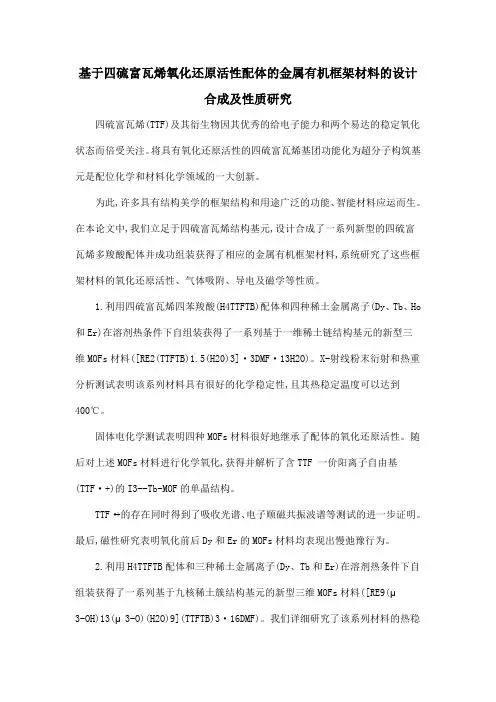
基于四硫富瓦烯氧化还原活性配体的金属有机框架材料的设计合成及性质研究四硫富瓦烯(TTF)及其衍生物因其优秀的给电子能力和两个易达的稳定氧化状态而倍受关注。
将具有氧化还原活性的四硫富瓦烯基团功能化为超分子构筑基元是配位化学和材料化学领域的一大创新。
为此,许多具有结构美学的框架结构和用途广泛的功能、智能材料应运而生。
在本论文中,我们立足于四硫富瓦烯结构基元,设计合成了一系列新型的四硫富瓦烯多羧酸配体并成功组装获得了相应的金属有机框架材料,系统研究了这些框架材料的氧化还原活性、气体吸附、导电及磁学等性质。
1.利用四硫富瓦烯四苯羧酸(H4TTFTB)配体和四种稀土金属离子(Dy、Tb、Ho 和Er)在溶剂热条件下自组装获得了一系列基于一维稀土链结构基元的新型三维MOFs材料([RE2(TTFTB)1.5(H20)3]·3DMF·13H2O)。
X-射线粉末衍射和热重分析测试表明该系列材料具有很好的化学稳定性,且其热稳定温度可以达到400℃。
固体电化学测试表明四种MOFs材料很好地继承了配体的氧化还原活性。
随后对上述MOFs材料进行化学氧化,获得并解析了含TTF 一价阳离子自由基(TTF·+)的I3--Tb-MOF的单晶结构。
TTF·+的存在同时得到了吸收光谱、电子顺磁共振波谱等测试的进一步证明。
最后,磁性研究表明氧化前后Dy和Er的MOFs材料均表现出慢弛豫行为。
2.利用H4TTFTB配体和三种稀土金属离子(Dy、Tb和Er)在溶剂热条件下自组装获得了一系列基于九核稀土簇结构基元的新型三维MOFs材料([RE9(μ3-OH)13(μ3-O)(H2O)9](TTFTB)3·16DMF)。
我们详细研究了该系列材料的热稳定性、N2吸附BET比表面积、电化学活性和稀土的特征荧光性质。
随后对上述MOFs材料进行化学氧化,并结合吸收光谱、电子顺磁共振波谱等测试对其TTF·+成分进行分析。
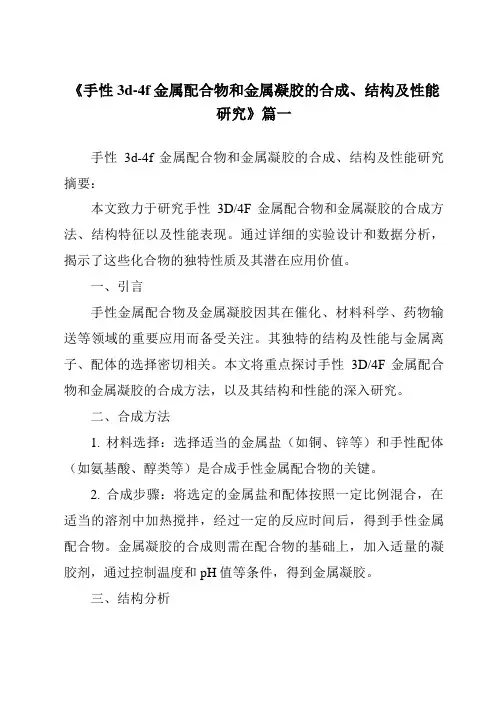
《手性3d-4f金属配合物和金属凝胶的合成、结构及性能研究》篇一手性3d-4f金属配合物和金属凝胶的合成、结构及性能研究摘要:本文致力于研究手性3D/4F金属配合物和金属凝胶的合成方法、结构特征以及性能表现。
通过详细的实验设计和数据分析,揭示了这些化合物的独特性质及其潜在应用价值。
一、引言手性金属配合物及金属凝胶因其在催化、材料科学、药物输送等领域的重要应用而备受关注。
其独特的结构及性能与金属离子、配体的选择密切相关。
本文将重点探讨手性3D/4F金属配合物和金属凝胶的合成方法,以及其结构和性能的深入研究。
二、合成方法1. 材料选择:选择适当的金属盐(如铜、锌等)和手性配体(如氨基酸、醇类等)是合成手性金属配合物的关键。
2. 合成步骤:将选定的金属盐和配体按照一定比例混合,在适当的溶剂中加热搅拌,经过一定的反应时间后,得到手性金属配合物。
金属凝胶的合成则需在配合物的基础上,加入适量的凝胶剂,通过控制温度和pH值等条件,得到金属凝胶。
三、结构分析1. 晶体结构:通过X射线单晶衍射技术,可以明确地观察到手性金属配合物的晶体结构。
这些化合物通常展现出独特的配位模式和空间排列。
2. 凝胶结构:扫描电子显微镜(SEM)和透射电子显微镜(TEM)等手段可用于观察金属凝胶的微观结构,包括其孔隙大小、分布及形状等。
四、性能研究1. 光学性能:手性金属配合物具有独特的光学性质,如圆二色性(CD)和荧光性质。
这些性质使得它们在光学材料和生物传感器等领域具有潜在应用。
2. 催化性能:部分手性金属配合物表现出良好的催化活性,可以用于有机反应的催化剂。
此外,金属凝胶也可能具有催化作用,尤其是在一些复杂的化学反应中。
3. 物理性能:金属凝胶的物理性质如机械强度、稳定性等也是研究的重要方面。
这些性质决定了其在材料科学中的应用潜力。
五、结论本文通过实验研究和数据分析,深入探讨了手性3D/4F金属配合物和金属凝胶的合成方法、结构特征以及性能表现。
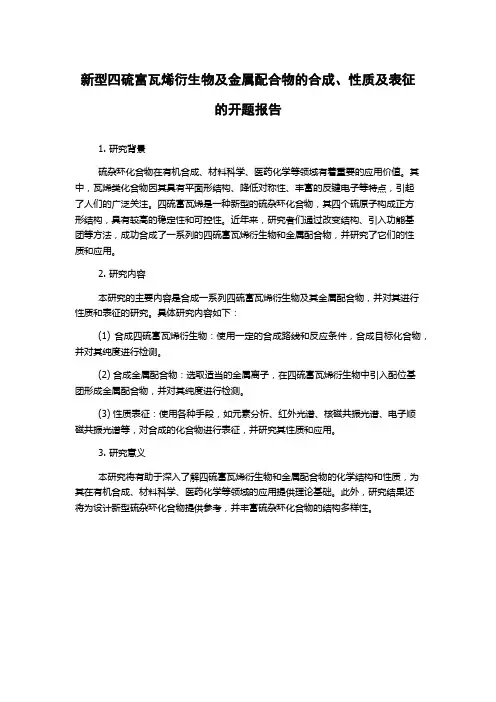
新型四硫富瓦烯衍生物及金属配合物的合成、性质及表征
的开题报告
1. 研究背景
硫杂环化合物在有机合成、材料科学、医药化学等领域有着重要的应用价值。
其中,瓦烯类化合物因其具有平面形结构、降低对称性、丰富的反键电子等特点,引起
了人们的广泛关注。
四硫富瓦烯是一种新型的硫杂环化合物,其四个硫原子构成正方
形结构,具有较高的稳定性和可控性。
近年来,研究者们通过改变结构、引入功能基
团等方法,成功合成了一系列的四硫富瓦烯衍生物和金属配合物,并研究了它们的性
质和应用。
2. 研究内容
本研究的主要内容是合成一系列四硫富瓦烯衍生物及其金属配合物,并对其进行性质和表征的研究。
具体研究内容如下:
(1) 合成四硫富瓦烯衍生物:使用一定的合成路线和反应条件,合成目标化合物,并对其纯度进行检测。
(2) 合成金属配合物:选取适当的金属离子,在四硫富瓦烯衍生物中引入配位基
团形成金属配合物,并对其纯度进行检测。
(3) 性质表征:使用各种手段,如元素分析、红外光谱、核磁共振光谱、电子顺
磁共振光谱等,对合成的化合物进行表征,并研究其性质和应用。
3. 研究意义
本研究将有助于深入了解四硫富瓦烯衍生物和金属配合物的化学结构和性质,为其在有机合成、材料科学、医药化学等领域的应用提供理论基础。
此外,研究结果还
将为设计新型硫杂环化合物提供参考,并丰富硫杂环化合物的结构多样性。

聚4-乙烯基吡啶金属络合物聚4-乙烯基吡啶(Poly(4-vinylpyridine))是一种具有重要应用潜力的聚合物。
它是由4-乙烯基吡啶单体通过聚合反应合成而成的。
聚4-乙烯基吡啶具有许多独特的化学和物理性质,使其在各种领域中得到广泛应用,尤其是在金属络合物的制备中。
金属络合物是指由金属离子与配位体形成的稳定络合物。
聚4-乙烯基吡啶具有较高的亲金属能力,可以与金属离子形成稳定的络合物。
由于聚4-乙烯基吡啶在水中具有溶解性,因此可以在水相中与金属离子反应形成金属络合物。
在制备聚4-乙烯基吡啶金属络合物时,一种常用的方法是将金属离子溶解于水中,然后加入适量的聚4-乙烯基吡啶溶液。
金属离子与聚4-乙烯基吡啶发生配位反应,形成金属络合物。
反应通常在室温下进行,并且可以根据需要调整溶液的pH值和金属离子浓度,以控制金属络合物的形成。
聚4-乙烯基吡啶金属络合物具有许多重要的应用。
首先,它们在催化反应中具有重要作用。
金属络合物可以作为催化剂来促进化学反应的进行。
聚4-乙烯基吡啶金属络合物可以提供高效的活性位点,从而增加反应速率和选择性。
此外,聚4-乙烯基吡啶金属络合物还可以用作催化剂的稳定剂,提高催化剂的循环使用寿命。
其次,聚4-乙烯基吡啶金属络合物在材料科学领域具有广泛的应用。
金属络合物可以对材料的性能进行改善和调节。
聚4-乙烯基吡啶金属络合物可以用于制备具有特殊性能的功能材料,如气凝胶、膜材料和聚合物复合材料。
这些材料在吸附分离、气体存储、传感器和催化等方面具有潜在的应用价值。
此外,聚4-乙烯基吡啶金属络合物还在生物医学领域中得到广泛应用。
金属络合物可以用于制备具有生物活性的聚合物材料,如药物传递系统、生物传感器和组织工程材料。
聚4-乙烯基吡啶金属络合物可以通过调节金属配位的类型和强度来改变材料的生物相容性和生物活性,从而实现对生物体的精确控制。
总之,聚4-乙烯基吡啶金属络合物是一种具有突出性能和应用潜力的聚合物。
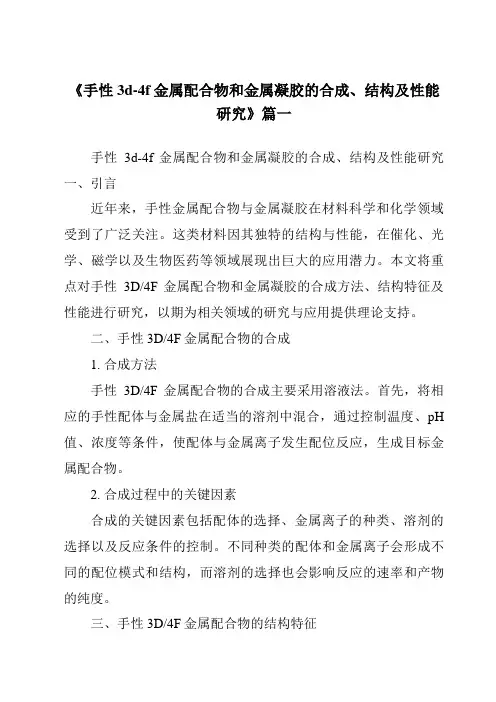
《手性3d-4f金属配合物和金属凝胶的合成、结构及性能研究》篇一手性3d-4f金属配合物和金属凝胶的合成、结构及性能研究一、引言近年来,手性金属配合物与金属凝胶在材料科学和化学领域受到了广泛关注。
这类材料因其独特的结构与性能,在催化、光学、磁学以及生物医药等领域展现出巨大的应用潜力。
本文将重点对手性3D/4F金属配合物和金属凝胶的合成方法、结构特征及性能进行研究,以期为相关领域的研究与应用提供理论支持。
二、手性3D/4F金属配合物的合成1. 合成方法手性3D/4F金属配合物的合成主要采用溶液法。
首先,将相应的手性配体与金属盐在适当的溶剂中混合,通过控制温度、pH 值、浓度等条件,使配体与金属离子发生配位反应,生成目标金属配合物。
2. 合成过程中的关键因素合成的关键因素包括配体的选择、金属离子的种类、溶剂的选择以及反应条件的控制。
不同种类的配体和金属离子会形成不同的配位模式和结构,而溶剂的选择也会影响反应的速率和产物的纯度。
三、手性3D/4F金属配合物的结构特征1. 晶体结构分析通过X射线单晶衍射技术,可以确定手性3D/4F金属配合物的晶体结构。
这些配合物通常呈现出多核、多维度的结构特点,其中金属离子与配体之间通过配位键相互连接,形成复杂的网络结构。
2. 分子间相互作用除了配位键外,分子间还存在氢键、范德华力等相互作用,这些相互作用进一步稳定了配合物的结构。
四、金属凝胶的合成与结构特征1. 金属凝胶的合成金属凝胶的合成通常采用溶胶-凝胶法。
在一定的条件下,金属配合物溶液可以发生凝胶化反应,形成三维网络结构的金属凝胶。
2. 结构特征金属凝胶具有三维网络结构,其中金属离子与配体通过配位键相互连接,形成交联的网络。
这种结构使得金属凝胶具有较高的比表面积和孔隙率,有利于物质的传输和反应。
五、性能研究1. 催化性能手性3D/4F金属配合物在催化领域具有广泛应用。
其独特的结构使得它们在有机合成、氧化还原反应等催化反应中表现出优异的性能。
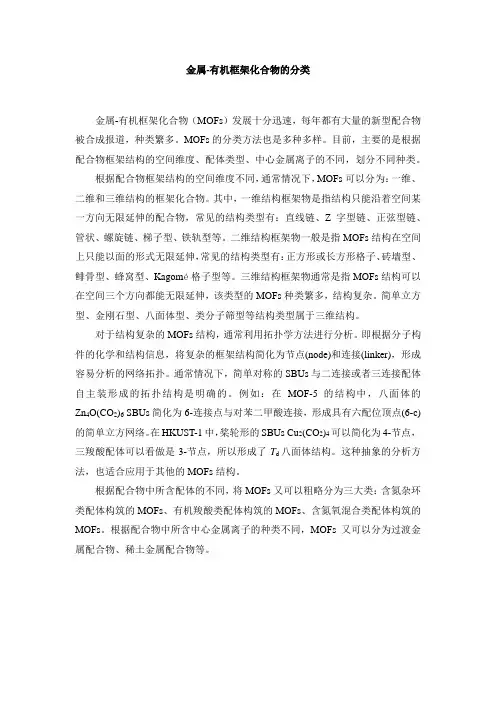
金属-有机框架化合物的分类金属-有机框架化合物(MOFs)发展十分迅速,每年都有大量的新型配合物被合成报道,种类繁多。
MOFs的分类方法也是多种多样。
目前,主要的是根据配合物框架结构的空间维度、配体类型、中心金属离子的不同,划分不同种类。
根据配合物框架结构的空间维度不同,通常情况下,MOFs可以分为:一维、二维和三维结构的框架化合物。
其中,一维结构框架物是指结构只能沿着空间某一方向无限延伸的配合物,常见的结构类型有:直线链、Z字型链、正弦型链、管状、螺旋链、梯子型、铁轨型等。
二维结构框架物一般是指MOFs结构在空间上只能以面的形式无限延伸,常见的结构类型有:正方形或长方形格子、砖墙型、鲱骨型、蜂窝型、Kagomé格子型等。
三维结构框架物通常是指MOFs结构可以在空间三个方向都能无限延伸,该类型的MOFs种类繁多,结构复杂。
简单立方型、金刚石型、八面体型、类分子筛型等结构类型属于三维结构。
对于结构复杂的MOFs结构,通常利用拓扑学方法进行分析。
即根据分子构件的化学和结构信息,将复杂的框架结构简化为节点(node)和连接(linker),形成容易分析的网络拓扑。
通常情况下,简单对称的SBUs与二连接或者三连接配体自主装形成的拓扑结构是明确的。
例如:在MOF-5的结构中,八面体的Zn4O(CO2)6 SBUs简化为6-连接点与对苯二甲酸连接,形成具有六配位顶点(6-c)的简单立方网络。
在HKUST-1中,桨轮形的SBUs Cu2(CO2)4可以简化为4-节点,三羧酸配体可以看做是3-节点,所以形成了T d八面体结构。
这种抽象的分析方法,也适合应用于其他的MOFs结构。
根据配合物中所含配体的不同,将MOFs又可以粗略分为三大类:含氮杂环类配体构筑的MOFs、有机羧酸类配体构筑的MOFs、含氮氧混合类配体构筑的MOFs。
根据配合物中所含中心金属离子的种类不同,MOFs又可以分为过渡金属配合物、稀土金属配合物等。
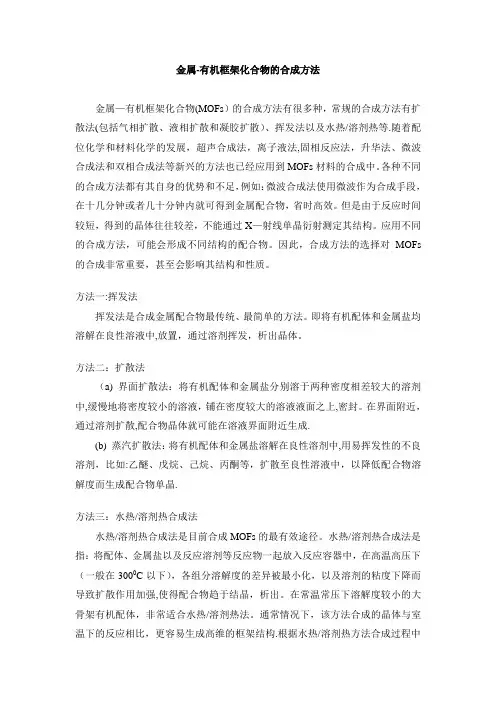
金属-有机框架化合物的合成方法金属—有机框架化合物(MOFs)的合成方法有很多种,常规的合成方法有扩散法(包括气相扩散、液相扩散和凝胶扩散)、挥发法以及水热/溶剂热等.随着配位化学和材料化学的发展,超声合成法,离子液法,固相反应法,升华法、微波合成法和双相合成法等新兴的方法也已经应用到MOFs材料的合成中。
各种不同的合成方法都有其自身的优势和不足,例如:微波合成法使用微波作为合成手段,在十几分钟或者几十分钟内就可得到金属配合物,省时高效。
但是由于反应时间较短,得到的晶体往往较差,不能通过X—射线单晶衍射测定其结构。
应用不同的合成方法,可能会形成不同结构的配合物。
因此,合成方法的选择对MOFs 的合成非常重要,甚至会影响其结构和性质。
方法一:挥发法挥发法是合成金属配合物最传统、最简单的方法。
即将有机配体和金属盐均溶解在良性溶液中,放置,通过溶剂挥发,析出晶体。
方法二:扩散法(a) 界面扩散法:将有机配体和金属盐分别溶于两种密度相差较大的溶剂中,缓慢地将密度较小的溶液,铺在密度较大的溶液液面之上,密封。
在界面附近,通过溶剂扩散,配合物晶体就可能在溶液界面附近生成.(b) 蒸汽扩散法:将有机配体和金属盐溶解在良性溶剂中,用易挥发性的不良溶剂,比如:乙醚、戊烷、己烷、丙酮等,扩散至良性溶液中,以降低配合物溶解度而生成配合物单晶.方法三:水热/溶剂热合成法水热/溶剂热合成法是目前合成MOFs的最有效途径。
水热/溶剂热合成法是指:将配体、金属盐以及反应溶剂等反应物一起放入反应容器中,在高温高压下(一般在3000C以下),各组分溶解度的差异被最小化,以及溶剂的粘度下降而导致扩散作用加强,使得配合物趋于结晶,析出。
在常温常压下溶解度较小的大骨架有机配体,非常适合水热/溶剂热法。
通常情况下,该方法合成的晶体与室温下的反应相比,更容易生成高维的框架结构.根据水热/溶剂热方法合成过程中用到的反应容器不同,又可以分为常见的反应釜和封管两种方法。
《手性3d-4f金属配合物和金属凝胶的合成、结构及性能研究》篇一手性3d-4f金属配合物和金属凝胶的合成、结构及性能研究摘要:本文致力于研究手性3D/4F金属配合物和金属凝胶的合成方法、结构特点以及性能表现。
通过详细的实验操作和理论分析,深入探讨了金属配合物与金属凝胶的合成条件、晶体结构、光学性质、磁学性质以及潜在应用。
研究结果表明,所合成的金属配合物和金属凝胶具有良好的手性特性、结构稳定性和优异性能,为相关领域的研究和应用提供了新的思路和方向。
一、引言手性金属配合物和金属凝胶是当前化学研究领域的热点之一。
它们不仅具有独特的结构和优良的物理化学性质,还在材料科学、药物化学、生物医学等领域展现出广阔的应用前景。
手性3D/4F 金属配合物和金属凝胶的研究对于探索新型功能材料具有重要意义。
二、实验部分1. 材料与方法(1)材料准备:实验所需金属盐、有机配体及其他化学试剂均为市售分析纯。
(2)合成方法:采用溶剂热法或溶液法,通过控制反应条件,合成手性3D/4F金属配合物和金属凝胶。
2. 合成步骤(1)金属配合物的合成:按照一定比例将金属盐和有机配体溶解在有机溶剂中,加入适量添加剂,在特定温度下反应一定时间,得到金属配合物晶体。
(2)金属凝胶的制备:将金属盐溶液与含有交联剂的凝胶前驱体混合,通过溶剂挥发或聚合反应,形成金属凝胶。
三、结果与讨论1. 晶体结构分析通过X射线单晶衍射分析,确定了金属配合物的晶体结构。
结果表明,金属离子与有机配体以特定的配位方式形成三维或四维的网络结构,呈现出手性特征。
金属凝胶的微观结构则通过扫描电子显微镜进行观察,揭示了其三维网状结构的细节。
2. 光学性质研究对金属配合物进行紫外-可见光谱分析,发现其具有优异的光吸收性能和光稳定性。
此外,通过圆二色光谱分析,证实了金属配合物的手性特征。
3. 磁学性质研究对部分金属配合物进行磁学性质测试,结果表明,这些配合物具有良好的磁响应性能,为磁性材料的应用提供了可能性。
金属有机配合物和mof 关系金属有机配合物(Metal-Organic Frameworks,MOFs)是一类由金属离子与有机配体组成的晶态材料。
其独特的结构和性质使其在多个领域具有广泛的应用前景。
本文将探讨金属有机配合物与MOFs 之间的关系,以及它们在材料科学和催化领域的应用。
金属有机配合物是由金属离子与有机配体通过配位键结合而成。
金属离子可以是过渡金属、稀土金属等,而有机配体则通常是含有氮、氧、硫等原子的有机化合物。
这种配位作用使得金属离子与有机配体形成稳定的结构,形成了多孔的晶体结构。
MOFs是一种由金属离子与有机配体组成的晶态材料。
由于金属离子与有机配体之间的配位作用,MOFs具有高度有序的孔道结构和大比表面积。
这使得MOFs在气体吸附、储能、分离等方面具有独特的性能。
同时,MOFs还具有可调控的孔道大小和功能化的特点,使其在催化反应中具有重要的应用价值。
金属有机配合物和MOFs之间存在着密切的关系。
金属有机配合物可以作为MOFs的前体,通过合适的合成方法转化为MOFs。
同时,金属有机配合物的结构和性质也为MOFs的设计和合成提供了重要的参考。
通过合理选择金属离子和有机配体的种类和比例,可以调控MOFs的结构和性能,实现对其物理和化学性质的精确控制。
金属有机配合物和MOFs在材料科学和催化领域具有广泛的应用前景。
MOFs的高度有序的孔道结构和大比表面积使其在气体吸附和储能材料中具有潜在的应用价值。
同时,MOFs还可以作为催化剂的载体,通过调控其结构和功能化,实现对催化反应的高效控制。
此外,金属有机配合物和MOFs还可以应用于分子传感、药物释放等领域。
金属有机配合物和MOFs之间存在着密切的关系,它们在材料科学和催化领域具有广泛的应用前景。
通过合理设计和合成金属有机配合物和MOFs,可以实现对其结构和性能的精确控制,从而实现对材料和催化反应的高效调控。
随着对金属有机配合物和MOFs的深入研究,相信它们将为我们带来更多的惊喜和应用价值。
四金属簇钨砷夹心型化合物[M4(H2O)2·(AsW9O34)
2]10-
四金属簇钨砷夹心型化合物[M4(H2O)2·(AsW9O34)2]10-(M=CuⅡ, CoⅡ, MnⅡ, NiⅡ, ZnⅡ)的合成、结构和磁特性研究取代型杂多化合物可改变多酸化合物的酸碱性、氧化还原性和热稳定性,因而受到关注[1]. 夹心型化合物是一类新型化合物,具有大的摩尔质量,高的负电荷,且含有多个磁性中心,近年来已引起国内外的兴趣[2].
作者:毕立华黄如丹彭军王恩波作者单位:毕立华(东北师范大学化学学院,长春,130024;吉林大学化学学院,长春,130023) 黄如丹,彭军,王恩波(东北师范大学化学学院,长春,130024)
刊名:高等学校化学学报ISTIC SCI PKU 英文刊名:CHEMICAL JOURNAL OF CHINESE UNIVERSITIES 年,卷(期):2002 23(5) 分类号: O612.6 关键词:夹心型杂多化合物合成结构磁特性。
新型四氧化三铁金属有机框架材料随着人类对环境问题日益关注,绿色材料的研究也越来越受到重视。
近年来,一种新型的金属有机框架材料——四氧化三铁金属有机框架材料成为了研究热点。
这种材料具有独特的结构和性能,可以广泛应用于催化、气体吸附等领域。
一、四氧化三铁金属有机框架材料的特点四氧化三铁金属有机框架材料,简称Fe-MOFs,由铁离子和有机配体组成。
与传统材料相比,Fe-MOFs具有以下特点:1.高孔径:Fe-MOFs中的铁离子可组成孔道,孔径大,可以吸附较大分子。
2.高比表面积:Fe-MOFs具有多孔结构,使得它的比表面积很大,有利于吸附、催化反应等。
3.可控合成:Fe-MOFs的合成过程中,配体的不同选择和铁离子的不同状态可以调控Fe-MOFs的结构和性能。
二、四氧化三铁金属有机框架材料的应用1.催化剂Fe-MOFs具有优异的催化性能。
研究表明,Fe-MOFs可以催化许多氧化、加氢、脱氢等反应。
它不仅可以提高反应速率和选择性,还可以降低催化剂的用量和反应温度,具有很好的实际应用前景。
2.气体吸附Fe-MOFs 带有孔道,可以吸附气体。
目前研究表明,Fe-MOFs可以吸附二氧化碳、甲烷等气体。
通过设计不同孔径大小的Fe-MOFs,可以提高它们对不同气体的吸附性能。
3.储能材料Fe-MOFs的独特结构可以被用作储能材料,特别是锂离子电池、电容器等方面。
其中,Fe-MOFs的电极性能很好,可大大改善锂离子电池的循环性能和放电性能。
三、Fe-MOFs的合成方法一般可以利用溶剂热法、水热法和微波法等方法来制备Fe-MOFs。
以溶剂热法为例,在铁盐、有机酸和溶剂的反应下,可以得到Fe-MOFs。
其中,有机酸的类型、浓度、反应温度和时间都会对Fe-MOFs的形貌和性能有影响。
因此,在合成过程中,需要合理选择反应条件以获得理想的Fe-MOFs。
四、未来展望Fe-MOFs的应用前景非常广阔,而且其未来仍有很多发展空间。